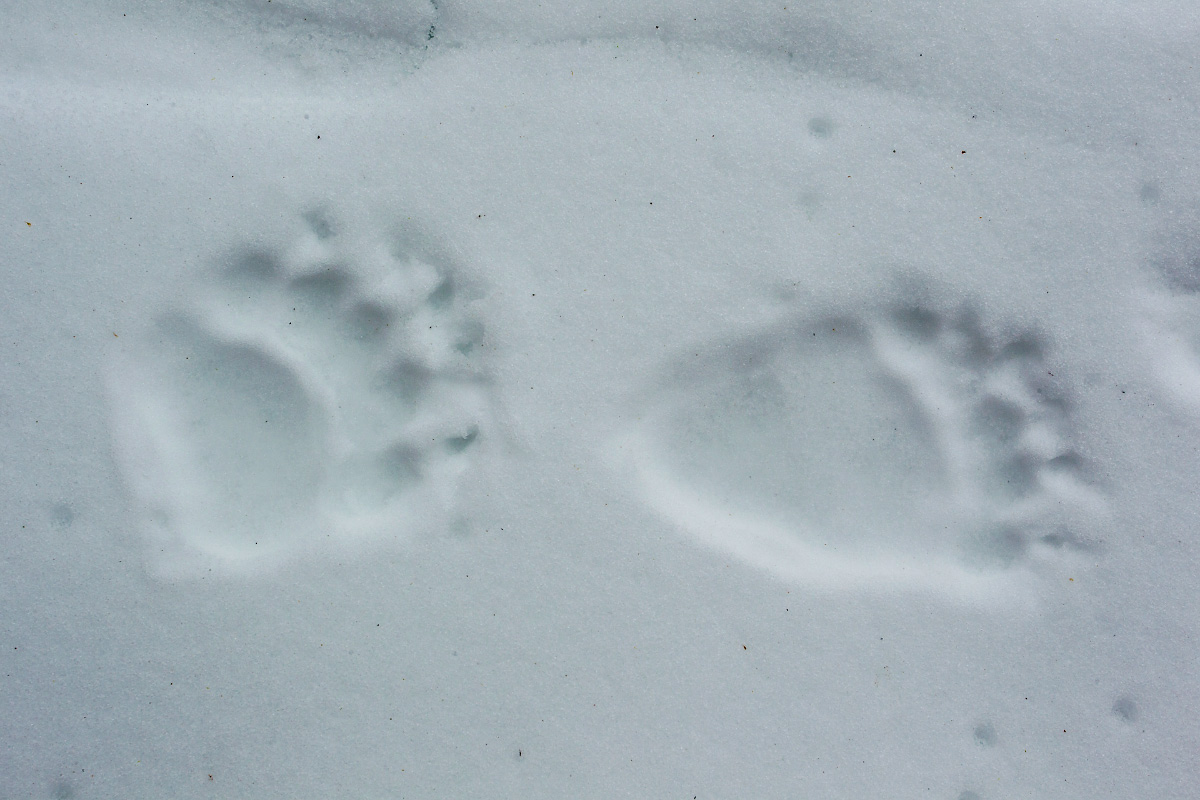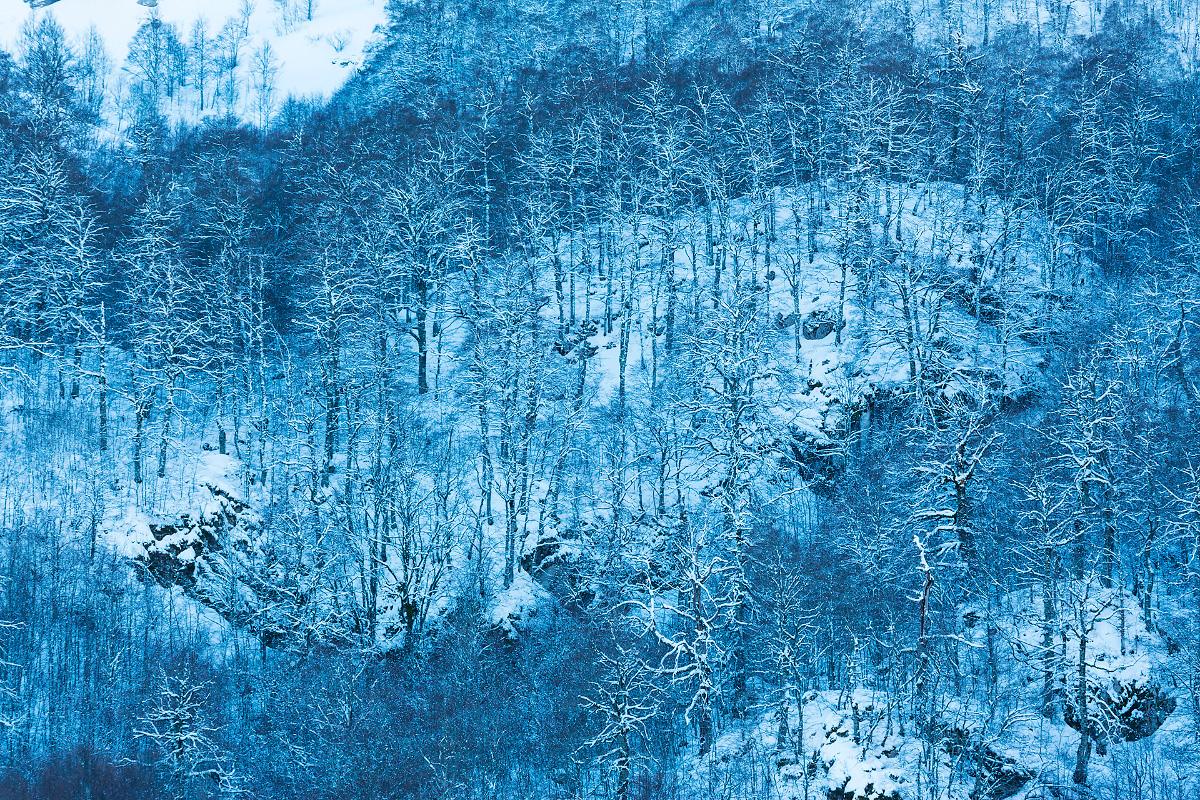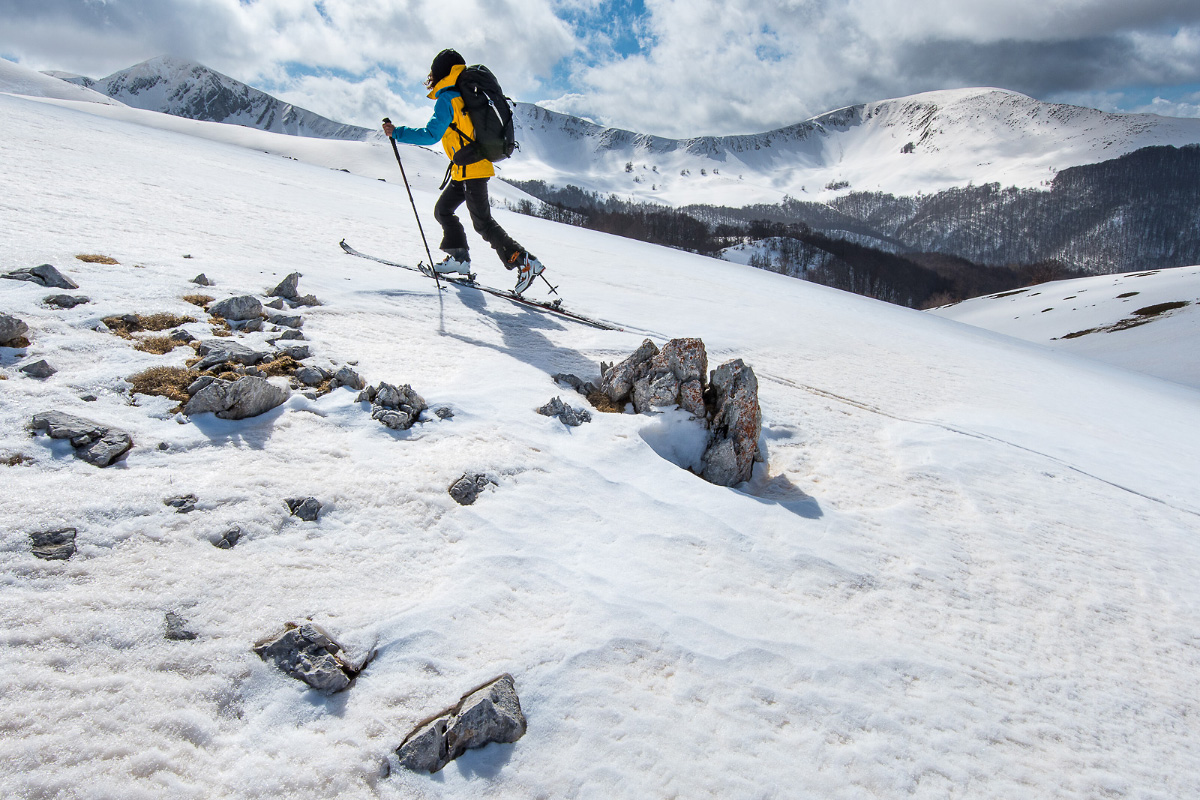The miracle of hibernation
Bears can spend up to six months sleeping in a den
It’s a late November morning. There’s been a light snowfall overnight and the ground is covered by a thin icy blanket, the prelude to heavier snow on the way.
Bear tracks lead up the valley floor and disappear into the beech forest, from where the bear will not emerge again until at least the end of March.
With the onset of winter, bears find themselves facing unfavourable conditions, with freezing temperatures and food shortages. They are, however, true strategists and spend all winter resting safely in a den. But their rest is more than just immobility.
Between the fourth and second week before the long winter sleep, bears in the Apennines gradually become lazier and more nocturnal. They limit their movements to no more than a kilometre from their future winter shelter and lose their appetite, until they enter a genuine state of dormancy, known more correctly as hibernation. In this state, bears do not feed, defecate or urinate. Their breathing slow down at 1 to 2 breaths per minute, white their heart rate at 8-10 beats per minute. Their metabolism “takes a break”. They literally “cool down” and their body temperature may drop as low as four to five degrees Celsius. And something amazing happens… it is precisely during this period that the pregnant females are about to give birth.
With the first snowfall, the bears’ long sleep begins in the safety of their caves.
Many of the physiological changes bears experience during hibernation are unique and still unknown.
Bears manage to counteract all the problems associated with months of immobility, fasting and urine retention. Something that smacks of magic even to the experts. To begin with, they don’t suffer from uraemia or dehydration. During hibernation, kidney function is drastically reduced and all urea is reabsorbed in the bladder. The volume of plasma flow decreases by 90%, as does oxygen consumption (up to 70% less) and filtration rate. Despite this, urea levels in the blood do not increase, quite the opposite, paradoxically they decrease.
How is that possible? Urea is a product of protein metabolism and during hibernation bears consume mainly fats. So urea production in bears is two to ten times slower in winter than in summer. In addition, the urea reabsorbed by the bladder passes into the intestinal lumen, where it is hydrolysed into ammonia by certain symbiotic bacteria. Once transported to the liver, the ammonia reacts with the glycerol released during lipolysis of the fat to produce amino acids, ideal to prevent loss of muscle mass. Incredibly, during hibernation the bears’ muscles do not, in fact, atrophy or lose strength. Bears lose just ten to fifteen percent of their muscle proteins and keep their muscles active and toned by shivering, with very short (about 0.2 seconds) muscle contractions repeated every three to ten seconds. Neither do bears suffer from osteoporosis, meaning their bone tissue doesn’t degenerate and lose density. They can therefore tolerate the high levels of fat in circulation without risking atherosclerosis or heart disease.
A life born from sleep and in counter-tendency
Unlike other bears, the body temperature of pregnant females increases from late November and remains high until about February. The embryo requires heat (euthermia) to develop. Bears are the only mammals capable of giving birth and nursing in such extreme conditions. But what happens in females during the months leading up to winter? After fertilisation in spring or early summer, the embryo stops developing and enters diapause at the blastocyst stage (a few hundred cells). The female bear may enter the den as early as October or November and this does not necessarily coincide with resumption of gestation, usually between November and December. One of the factors triggering development of the foetus in the females is undoubtedly the shorter photoperiod (the number of hours of light typical of early winter). Females therefore remain warm until they give birth. From then on, the female goes into a state of inactivity to avoid crushing and suffocating the young.

The moment when the bears enter or leave the den is triggered by a variety of environmental factors and the characteristics of the individual bears.
How long do bears hibernate? This depends on the interaction of numerous factors: environmental conditions, physical needs and the nutritional status of the animals. The first snowfall, a drop in outside temperatures, the hours of light and amount of food available in the wild are all decisive in triggering the beginning of the long sleep. At southern latitudes, for example, brown bears enter the den later and spend less time in hibernation than bears living at colder, snowier northern latitudes. But to determine the duration of hibernation, an optimal ratio between weight and accumulated fat is decisive. Where the energy balance of feeding during winter is more favourable than hibernation, it may be advantageous for some bears to remain active for all or part of the winter. In fact, in temperate climates where food sources are accessible even during winter, individuals with a delicate energy balance, such as young bears just a few years old, or females accompanied by cubs born during the summer, remain more alert than other bears. In the Apennines, most of the bears monitored spend the winter in the den, but in years with little snow and preceded by an autumn with abundant production of beech nuts or acorns, a juvenile and a female in the company of her two cubs spent the entire winter eating nuts.

Most of the known bear dens in the Apennines are located in rock systems within the most remote and tranquil beech forests.
In the Apennines, bears generally enter the den with the season’s first snowfall. Females are the first to retire around the end of November, but some may already be in their den as early as the first week of November. The latest generally wait at most until mid-December. Males wait longer. They usually make up their minds around 8 December, but may put hibernation off until the end of the year. Due to their size and weight, males consume energy more slowly and so can stay active longer. The reawakening of bears is as gradual as their entry into the den. They first go through a phase of “walking hibernation” and do not resume their normal pace until a week after leaving the den. At the end of March, males and females abandon their den, although females may wait until mid-April when the temperatures are rising the fastest and the snows are melting. The “sleepiest” are the pregnant females who usually enter the den first and may remain nearby until as late as the end of May, given that they need to take care of the still relatively immobile cubs.
Hibernation and climate change
Do bears sleep less when it’s warm? That’s the question some researchers have tried to answer by analysing 69 years of den entry and exit data from 12 protected areas in Russia. The findings show that a rise in ambient temperature in the period immediately before the bears come out of their den does in fact induce them to wake up from their winter sleep earlier. A 20-year study in the Cantabrian Mountains in Spain came to the same conclusion: in particularly warm springs, females with their young emerge from their dens ahead of time. What impact could this have on a bear’s life? Researchers as yet don’t have the answer. What is certain is that it will all depend on the effect of climate change in the spring on the foods bears find most appetising.

In the Apennines, some bears remain in hibernation all through winter, others interrupt the period of dormancy for even as long as 10 days in search of food.
More than half the bears studied generally used just one winter den throughout the entire hibernation period, while the remaining animals changed dens at least once between January and March, finding a second den within a few kilometres of the first. Although a den may be abandoned for natural reasons (floods, earthquakes), man is the main cause. During research, it was demonstrated that the abandonment of a den between January and February coincided with the passage of hikers. But the changes occurring between late February and March generally coincided with an increase in average seasonal temperatures, perhaps suggesting an early attempt to explore or move nearer to the spring feeding grounds. In fact, excrement was found in more than half the second dens, indicating that the bears had fed in the meantime.
The natural rock cavities chosen by bears for their dens have small openings and just the right size to accommodate a single animal, ideal for keeping warm.
The choice of an ideal shelter is critical as it must provide protection from adverse weather conditions and predators, especially in the case of nursing mothers. Bears may use their den as a simple bed, or they may even excavate a genuine underground “mini-apartment”. All depends on the local climate and geomorphology, together with, last but not least, the animal’s sex, age and, in the case of a female, whether or not she will be giving birth. But brown bears usually dig out a tunnel or look for natural caves. In the Apennines, the karst geomorphology provides them with a wide choice of cavities and natural caves. And in fact, a natural cavity offers not only physical protection, but also a relatively stable, dry and thermally and acoustically insulated environment. These characteristics are ideal in humid temperate environments where temperatures rarely fall below -10°C and where winter precipitation may sometimes be in the form of rain.
What is a bear’s den like in the Apennines? A den generally consists of an entrance, a tunnel or “antechamber” and a main “room”. The entrance is usually low and wide to encourage accumulation of snow in front, providing thermal insulation and reducing heat loss. The height and width of the chamber are proportional to the size of the bear and in most cases (80% of the dens examined) it contains a bed made of earth, leaves and twigs, ideal for insulating the animal from the ground. The small size of the den compared to the dimensions of the bear guarantees better thermal stability.
Bears tend to hibernate in inaccessible places with very complex orography and little human disturbance.
Bears generally do not use the same dens from one year to the next. However, one or more individuals may choose to hibernate in the same areas. What are the ideal requirements of a hibernation site? A stable temperature, security, tranquillity and proximity to spring foods. In the Apennines, bears select inaccessible, undisturbed locations. Most of the dens are situated at high altitudes (about 1600 m), below the limit of the trees in beech forests, on very steep slopes (with gradients of about 35°) and one to three kilometres away from roads or inhabited areas. Steep slopes at high altitudes also help keep the den thermally insulated. On one hand, the more abundant snow cover closes the entrance, on the other, these slopes are the first to be freed from the snow in the spring. Bears do not have a preferred exposure, but take into account the local microclimate deriving from the physical structure and vegetation in the area immediately surrounding the den (presence of rocks, trees and vegetation). Proximity to spring feeding areas would seem to be a factor, especially for females. In the first weeks after leaving the den, the females, in fact, tend to move around and feed in a limited area of about three to four kilometres around the location of the den.

On a warm April afternoon, a bear moves around near the den where it spent the winter.
Bears have a light sleep. In the den, they remain very reactive to disturbance and once awake they are immediately in full form.
The body temperature of bears decreases in the den, but only slightly, so they can still react to external stimuli. But what are a bear’s reactions if disturbed while sleeping? In the best of situations, the bears stay in their dens, but their heart rate and temperature increase and do not return to hibernation rhythms until two or three weeks later, with considerable consumption of energy reserves. On the other hand, as documented by a number of studies, the presence of human activities (forestry, hunting, the passage of people and research activities) even as far away as a kilometre (200 m at drastic levels) from a winter den can induce bears to move away. This is especially so if the disturbance occurs in the first few months after entry. When this happens, bears may experience significant weight loss (over 25%). In Sweden, a study of 90 bears fitted with tracking collars showed that 22% of bears leave or change dens during the winter. In the case of pregnant females in particular, this change led to the abandonment or death of the young. Under extreme conditions (for example, if the bears were captured and handled in their den), the abandonment rate rose to 92%. Some bears were able to find a new den, but only after several weeks and by travelling long distances, while others interrupted their winter sleep definitively. All this in extreme temperatures and with no opportunity to feed.

In the Apennines, only three to four females breed each year. To give births to cubs, they need safe and inaccessible places. This is why it is essential to strictly protect these very sensitive areas. Especially in winter, it is important not to leave the established paths and to respect any regulations issued by the competent authorities.
In the Apennines, almost half the known dens fall outside the protected area of the Abruzzo, Lazio and Molise National Park. The dates of den entry and exit coincide with the start of numerous human activities (hunting, forestry, dog training, sports and recreational activities, truffle hunting and the search for deer antlers) which could interfere with the bear’s dormancy.
When a female leaves the den prematurely, not only is there a high energy cost, but also a tenfold increase in the risk of the cubs dying. Failure to take action to reduce the impact of these activities in these areas will seriously jeopardise the future of this species.

